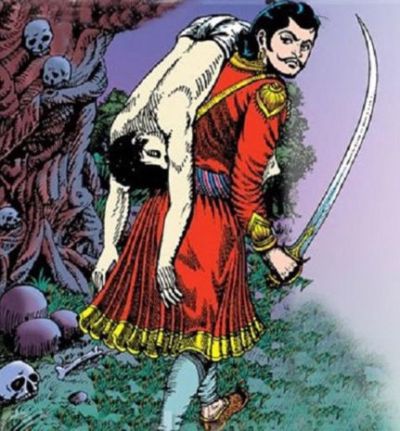Read the previous part here…
The Baitāl started to speak, once again.
“O King, you have taken on a very troublesome and tiresome task! So let me tell you a tale, to amuse you…“

अग्निस्वामीति तत्रासीद् ब्राह्मणो वेदपारगः ।
तस्यातिरूपा मन्दारवतीत्य् अजनि कन्यका ॥ १२,९.६ ॥
यां निर्माय नवानर्घलावण्यां नियतं विधिः ।
स्वर्गस्त्रीपूर्वनिर्माणं निजम् एवाजुगुप्सत ॥ १२,९.७ ॥
तस्यां च यौवनस्थायाम् आययुः कान्यकुब्जतः ।
समसर्वगुणास् तत्र त्रयो ब्राह्मणपुत्रकाः ॥ १२,९.८ ॥
तेषां चात्मार्थम् एकैकस् तत्पितुस् ताम् अयाचत ।
अनिच्छन् दानम् अन्यस्मै तस्याः प्रानव्ययाद् अपि ॥ १२,९.९ ॥
तत्पिता स तु तन्मध्यान् नैकस्मा अपि तां ददौ ।
भीतो ऽन्ययोर् वधात् तेन तस्थौ कन्यैव सा ततः ॥ १२,९.१० ॥
ते च त्रयो ऽपि तद्वक्त्रचन्द्रैकासक्त दृष्ठयः ।
चकोरव्रतम् आलम्ब्य तत्रैवासन् दिवानिशम् ॥ १२,९.११ ॥
On the banks of the river Yamunā, lies a place named Brahmasthala (the abode of Brahmins). There lived a Brahmin named Agnisvāmin (the lord of Agni), and he had spent his whole life mastering the Vedas. He had a beautiful daughter named Mandāravatī. They say that when she was born, Brahma himself felt that the apsaras in swarga were nothing in front of his new creation.
She grew up into an even more beautiful lady, and thee young Brahmins came all the way from Kānyakubja, in order to ask her hand in marriage. Now, the three appeared equal in all aspects – physical, mental and spiritual, and also in accomplishments.
They each met Agnisvāmin separately, and each wanted to marry her, and also said that they would rather sacrifice their lives, than to see her married to any of the other two.
This presented a conundrum to the father, who then decided to keep her unmarried rather than marrying her off and being the cause of the death of the other two. And so Mandāravatī remained unmarried, and the three Brahmins remained in Brahmasthala, their eyes transfixed on her moon-like radiance, much like the Chakora bird, that lives it’s life merely to look at the moon..
अथाकस्मात्समुत्पन्न दाहज्वरवशेन सा ।
जगाम मन्दारवती कुमारी किल पञ्चताम् ॥ १२,९.१२ ॥
ततस् तां विप्रपुत्रास् ते परासुं शोकविक्लवाः ।
कृतप्रसाधनां नीत्वा श्मशानं चक्रुर् अग्निसात् ॥ १२,९.१३ ॥
एकश् च तेषां तत्रैव विधाय मठिकां ततः ।
कृततद्भस्मशय्यः सन्न् आस्तायाचितभैक्षभुक् ॥ १२,९.१४ ॥
द्वितीयो ऽस्थीन्य् उपादाय तस्या भागीरथीं ययौ ।
तृतीयस् तापसो भूत्वा भ्रान्तुं देशान्तराण्य् अगात् ॥ १२,९.१५ ॥
स भ्राम्यंस् तापसः प्राप ग्रामं वक्रोलकाभिधम् ।
तत्रातिथिः सन् कस्यापि विप्रस्य प्राविशद् गृहम् ॥ १२,९.१६ ॥
तत्पूजितः स यावच् च भोक्तुं तत्र प्रचक्रमे ।
तावद् एकः शिशुस् तत्र प्रवृत्तो ऽभूत् प्ररोदितुम् ॥ १२,९.१७ ॥
स सान्त्व्यमानो ऽपि यदा न व्यरंसीत् तदा क्रुधा ।
बाहाव् आदाय गृहिणी ज्वलत्य् अग्नौ तम् अक्षिपत् ॥ १२,९.१८ ॥
In an unfortunate turn of events, Mandāravatī suddenly contracted a high fever, and it did not subside for two days.
The vaidyas (doctors) tried to save her, but were unsuccessful, She died on the third day.
The three young Brahmins, grief-stricken, carried her body to the cremation ground on the banks of the Ganga, and cremated her on the same day. They were unable to overcome their grief, and so the first of them built a hut right there, and made her ashes as his bed. He spent his days begging for alms. The second took her asthi (remains) and started on a pilgrimage to the Himalayas. The third became a sanyasi, and started to travel all through Bharatvarshā.
During his travels, he reached a village named Vajraloka. He was invited into the house of a Brahmin, who received him with all due honors and served him water. They were just preparing to sit down to eat, when a child began to cry in the adjoining room. It cried and cried, and would not stop in spite of all the efforts of the lady of the house to calm it down.
Infuriated, she took the child in her arms and threw it into the fire!
to be continued…
